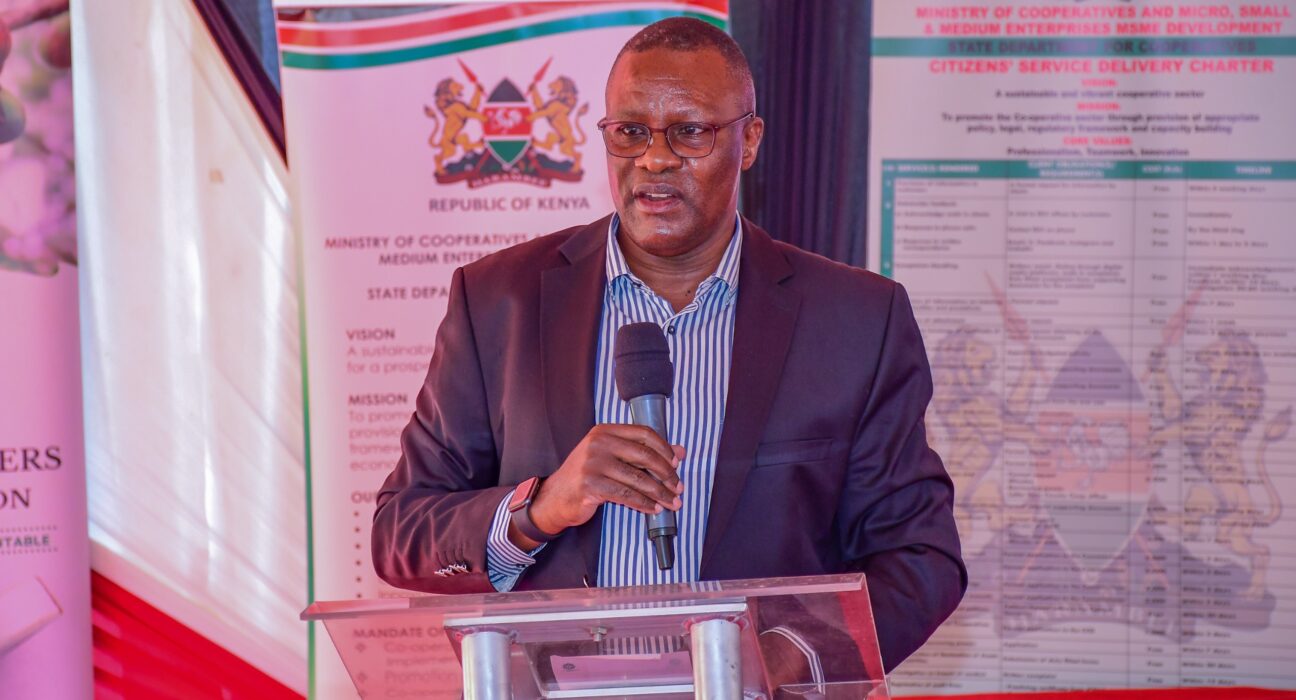Eliud Owalo, Deputy Chief of Staff for Performance and Delivery Management at the Executive Office of the President, has proposed a performance-based management framework that links public sector funding and rewards to measurable results. Announced during a ministerial performance review retreat hosted by the Ministry of Cooperatives and Micro, Small and Medium Enterprises (MSMEs) in Nanyuki, the plan introduces a “reward and sanction regime” to incentivize high-performing ministries, departments, and agencies (MDAs) while penalizing underperformers. With Kenya’s public sector accounting for 47% of the national budget (Kenya National Bureau of Statistics, 2024), the proposal aims to boost efficiency but has ignited debate over its feasibility and fairness.
Details of Owalo’s Performance-Based Management Proposal
Speaking at the Nanyuki retreat, Owalo outlined a framework to transform how Kenya’s public sector operates. “Government organizations will now be required to demonstrate tangible results in line with their mandates,” he stated, emphasizing that funding allocations will depend on performance outcomes. High-performing MDAs could receive increased budgets, while underperformers face sanctions, such as reduced funding or restructuring.
Key Elements of the Proposal:
- Reward and Sanction System: Budgets and incentives tied to measurable results, with sanctions for MDAs failing to meet targets.
- Performance Contracts: MDAs must sign contracts by July 1, 2025, for the 2025/2026 financial year, cascading to individual staff scorecards.
- Strategic Planning Deadline: All MDAs to finalize strategic plans and service charters by June 30, 2024, aligned with annual work plans.
- Service Level Agreements (SLAs): Formal agreements between MDAs to improve coordination and reduce operational overlaps.
- Public Reporting: Quarterly forums to share progress, enhancing transparency and public trust.
- Resource Mobilization: MDAs encouraged to attract external funding from private partners or donors, reducing reliance on the National Treasury.
Owalo stressed the importance of strategic planning, warning, “Without a strategic plan, you’re leaving everything to chance and are likely to fail.” He also highlighted midterm reviews of five-year plans to refine priorities for the remaining 2.5 years of the Kenya Kwanza administration’s term.
Context: The Nanyuki Retreat and Sector Focus
The retreat, organized by Cabinet Secretary for Cooperatives and MSMEs Wycliffe Oparanya, was described by Owalo as a “first-of-its-kind” event focused on delivery. Attended by senior officials, including Principal Secretaries Susan Mang’eni (MSMEs) and Patrick Kilemi (Cooperatives), and CEOs from the Hustler Fund, Micro and Small Enterprises Authority (MSEA), and New Kenya Cooperative Creameries (New KCC), the event prioritized six focus areas: three in MSMEs and three in cooperatives.
Key Sector Initiatives:
- Coffee Sector Reform: Oparanya called coffee “our gold,” noting ongoing reviews of the Coffee Act to modernize production and exports, which generate Ksh 120 billion annually (Kenya Coffee Traders Association, 2024).
- Cooperatives Act Amendments: Updates to governance structures, currently under Senate review, to strengthen the sector.
- MSME Support: Expansion of the Hustler Fund and MSEA programs to boost micro-entrepreneurship, critical as MSMEs employ 15 million Kenyans (KNBS, 2024).
Oparanya urged MDAs to “leave a mark” by prioritizing high-impact projects before the administration’s term ends in 2027, aligning with Owalo’s call for results-driven governance.
Mechanisms for Implementation
Owalo’s plan introduces structured mechanisms to ensure accountability and track progress, building on Kenya’s 2018 Public Service Performance Management Framework.
Implementation Timeline:
- By June 30, 2024: MDAs to finalize strategic plans and service charters.
- By July 1, 2025: Performance contracts signed for 2025/2026, linked to work plans and individual scorecards.
- Ongoing, 2025: Midterm reviews of five-year plans to adjust strategies.
- Quarterly, 2025: Public forums to report progress and challenges.
Monitoring Tools:
- Performance Contracts: Binding agreements for MDAs, evaluated by Owalo’s Public Service Performance Management Unit (PSPMU).
- Individual Scorecards: Metrics for staff at all levels, from Cabinet Secretaries to junior officers, to ensure personal accountability.
- SLAs: Agreements to streamline inter-agency operations, reducing delays in joint projects.
- Digital Tracking: Potential use of dashboards or software to monitor targets, as seen in Owalo’s prior ICT initiatives.
Owalo’s experience digitizing 17,668 government services as ICT Cabinet Secretary (2022–2024) suggests a tech-driven approach to monitoring, though details on tools remain unspecified.
Alignment with National and Regional Priorities
The framework requires MDAs to align strategic plans with key development agendas, ensuring coherence with Kenya’s long-term goals.
Aligned Frameworks:
- Bottom-Up Economic Transformation Agenda (BETA): Prioritizes agriculture, MSMEs, housing, healthcare, and digital economy to empower grassroots communities.
- Fourth Medium-Term Plan (MTP IV, 2023–2027): Part of Kenya Vision 2030, targeting 7% GDP growth through industrialization and infrastructure.
- Kenya Vision 2030: Aims for middle-income status by 2030 via investments in education, health, and technology.
- EAC Vision 2050: Promotes regional trade and integration in East Africa.
- AU Agenda 2063: Envisions a prosperous, integrated Africa with sustainable development.
This alignment aims to channel MDA efforts toward national priorities, such as increasing agricultural exports or achieving 80% water coverage by 2027, while supporting regional and continental objectives.
Opportunities and Challenges
Owalo’s framework offers significant opportunities to enhance public sector efficiency but faces notable hurdles.
Opportunities:
- Improved Accountability: Performance contracts and scorecards could reduce wastage, as seen in past reforms that saved Ksh 50 billion annually (Auditor General, 2023).
- Sectoral Impact: Prioritizing coffee and MSMEs could boost GDP by 5% by 2027, per World Bank projections.
- Public Trust: Transparent reporting via quarterly forums aligns with President Ruto’s county service charters, potentially increasing approval ratings.
- External Funding: Encouraging MDAs to attract private or donor funds could ease pressure on the National Treasury, mirroring successful PPPs in irrigation.
Challenges:
- Funding Limitations: With 47% of the budget allocated to salaries and debt servicing, rewarding high performers may strain resources.
- Bureaucratic Resistance: MDAs with entrenched practices may resist performance contracts, as seen in the uneven adoption of the 2018 framework.
- Capacity Gaps: Some MDAs lack the expertise to develop strategic plans or negotiate SLAs, requiring training and support.
- Risk of Inequity: Sanctions could exacerbate disparities in underfunded sectors, such as rural health facilities, if not balanced with capacity-building.
Owalo’s collaboration with the United Nations Development Programme (UNDP) for service delivery training may mitigate these challenges, but scaling up will be critical.
Broader Context: Public Sector Reform in Kenya
Kenya’s public sector has faced criticism for inefficiency, with only 60% of budgeted projects completed on time (Controller of Budget, 2024). Owalo’s plan builds on earlier reforms, such as the 2018 Public Service Performance Management Framework, which introduced performance contracting but struggled with enforcement. Recent sectoral evaluations, like the Ministry of Health’s 2024 contract vetting or Kenyatta University’s 2023/2024 review, show progress but highlight funding and capacity constraints.
Globally, performance-based management has succeeded in countries like Singapore and New Zealand, where clear metrics and incentives drive efficiency. Kenya’s adoption of this model, if well-executed, could position it as a regional leader in governance reform.
What This Means for Stakeholders
For MDAs:
- Action Required: Finalize strategic plans by June 30, and prepare performance contracts by July 1, 2025.
- Opportunity: High performers can secure larger budgets and showcase impact.
- Risk: Underperformers face funding cuts, requiring urgent operational improvements.
For Public Sector Employees:
- Impact: Individual scorecards will tie personal performance to job security and rewards.
- Recommendation: Engage in training to meet new metrics and align with MDA goals.
For Citizens:
- Benefit: Improved service delivery and transparency through quarterly updates.
- Role: Hold MDAs accountable by attending forums and monitoring progress via government platforms.
For Private Sector and Donors:
- Opportunity: Partner with MDAs on high-impact projects, leveraging strategic plans for PPPs or funding.
- Action: Engage with ministries like Cooperatives to support coffee or MSME initiatives.
Critical Questions Moving Forward
As Owalo’s plan unfolds, several questions remain:
- How will performance metrics be defined? Transparent, equitable criteria are essential to avoid bias.
- Can the National Treasury fund rewards? Fiscal constraints may limit the plan’s scalability.
- Will sanctions harm critical sectors? Health and education, already underfunded, need tailored support.
- How will public engagement be sustained? Quarterly forums must be accessible and inclusive to maintain trust.





